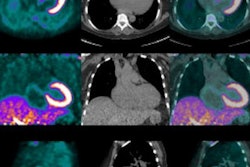The tracer is designed to highlight tau protein, which accumulates in the brain and has been linked with neurodegenerative disorders such as dementia, Alzheimer's, and, in some cases, chronic traumatic encephalopathy.
This study from Washington University in St. Louis included 53 cognitively normal participants with a clinical dementia rating of 0 (no indications of dementia) and 12 cognitively impaired individuals with a rating of at least 0.5. All 65 subjects underwent PET imaging with AV-1451 and structural MRI to calculate standardized uptake value ratios (SUVRs) for the whole cerebellum and 36 regions of interest.
The researchers then estimated the global PET tau burden for each subject by taking the mean SUVR from the entorhinal cortex, amygdala, inferior temporal cortex, and lateral occipital cortex. They found a significant relationship between global burden of PET tau and cortical thickness in the lateral inferior temporal, lateral occipital, and precuneus areas, which is consistent with PET tau uptake in Alzheimer's patients.
Based on the results, the researchers concluded that PET with AV-1451 correlates with regionally specific cortical thinning in Alzheimer's disease and could provide valuable insights into the disease. The study will be presented at RSNA 2016 by Shruti Mishra.




















